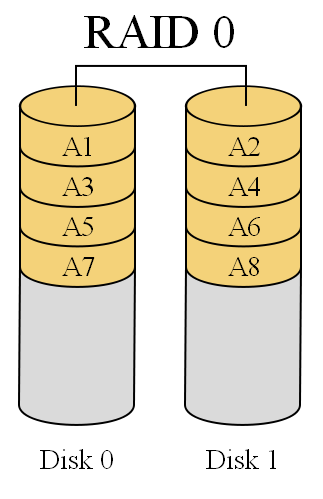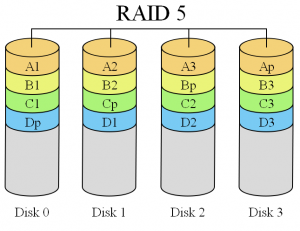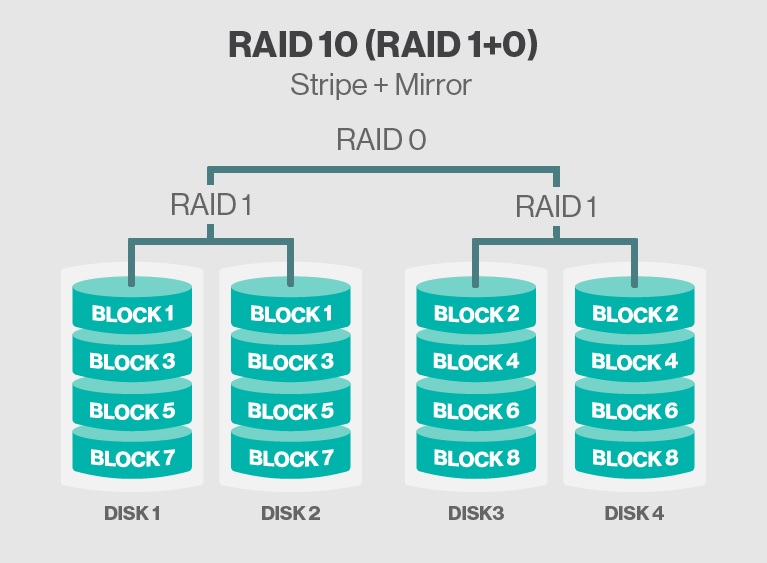RAID (Redundant Array of Independent Disks.)
Introduction and Definition:-
The term RAID is defined as redundant array of Inexpensive disks and is usually called as independent disks.
The storage of RAID has multiple no of disks in order to provide the fault tolerance and also to improve the overall performance and to increase storage capacity.
It is a technology that have greater levels of performance, reliability and large volumes of storage space that deals with data.
In older storage device the data is to be stored in single disk drive. This is called as SLED (single large expensive disk) this system have some drawbacks.
1. The data cannot be read from the disk quickly enough to keep the other system components.
2. Next if SLED fails the data is lost unless it has been recently have backup.

MTBF(mean time between failures) is the predicted elapsed time between inherent failures of a system during operation.
It is a measure of how reliable a hardware product or component is. For most components, the measure is typically in thousands or even tens of thousands of hours between failures.

How the RAID will works?
The RAID technology works by the data can be mirrored on one or more disks in the same array, so that if one disk fails the data is preserved.
In this technology Stripping technique is used( spreading data over multiple disk drives)
By this way the sequential data is broken into segments which are sent to the various disks in an array.
A typical RAID array uses multiple disks that appear to be a single device so it can provide more storage capacity than a single disk.

It is the simple diagram shown above will indicates the working of RAID.
Flavors of RAID:-
The following are the most commonly used one,
RAID 0-----------striping. Data is striped across multiple disks.
RAID 1-----------Mirroring. Data is written identically to a multiple of two disks simultaneously.
RAID 5-----------Stripping with parity. Data is striped across multiple disks and parity is written to one additional disk.
RAID 10---------combining RAID 1 and RAID 0
RAID 0

It splits data among two or more disks.
It provides good performance.(using multiple disks)
Lack of data redundancy that means there is no fail over support with this configuration
In the diagram the odd blocks are written to disk 0 and the even blocks to disk 1 such that A1,A2,A3,A4,...would be the order of blocks read if read sequentially from the beginning.
Used in read only NFS systems and gaming systems
Advantages:
Simple design.
Implementation is easy.
Over head is not involved here.
RAID 1
It is data mirroring.

Two copies of the data are held on two physical disks and the data is always identical.
Twice as many disks are required to store the same data when compared to RAID 0
Array continues to operate so long as at least one drive is functioning.
Advantages:
Transaction rate is higher.
100 % data redundancy.
No need to rebuild if the disk is failure.
RAID 5
It is an ideal combination and have good performance, fault tolerance and high capacity to have better storage efficiency.
An arrangement of parity and CRC to help rebuilding drive data in case of disk failure.
Distributed parity is employed here.
Data blocks are striped across the drives so that the drive have a parity check sum of all the block data is written.
The parity data is not to be written in a fixed drive, but they are spread across all drives.
Using the parity data, the computer can recalculate the data of one of the other data blocks, should those data no longer be available.
That means a RAID 5 array can withstand a single drive failure without losing data or access to data.
Advantages:
Controllable of disk is easy.
Exchange of heat disks is possible.
Reading and writing speed is high.
RAID 10
It is nothing but combination of RAID 1 and RAID 0
That means it requires a minimum of four disks to stripe the data across mirrored pairs.
As long as one disk in each mirrored pair is functional the data can be recovered.

And if the two disks in the same mirrored pair than all data will be lost, due to non parity in the striped sets.
By this the RAID 10 provides good redundancy and better performance suitable for I/O intensive applications.
Advantages:-
Fault tolerance is low.
High performance.
I/O rates are high due to RAID 1 segments.
High sustainability(it will tolerate several concurrent drive failures).
Choice for selecting the RAID controllers for servers.
There are several factors that determine and choose the correct RAID levels for your server.
Some of them are as follows
1.The level of data protection.
2.Performance of the controller.
3.Application’s used and Read/Write ratio.
4.Fault tolerance.
5.Reliability.
From the above details provided on this post will help you to know about the RAID and its working and also how to choose the correct RAID controller for your web server.
Hope i think it will help You.
To know Importance of TCP/IP in Computer networking click here.
